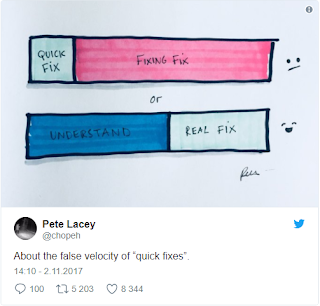Friday, December 8, 2017
Always say "Junk fix", never "quick fix"
One of the greatest examples of metaphor used to explain the nature of projects to stakeholders is a term coined by Ward Cunningham - technical debt. In very illustrative way it mimics well known figure of a financial debt to explain the costs or possible impact that unmaintained software brings to owners. In the opposite pole I can see a term used so often, while bringing so much confusion and leading to misunderstandings and even conflicts in many organisations. I mean the "quick fix". Quick and dirty, when we tend often to forget how dirty it was, leaving it in our software just to make it rot. Please keep in mind each time you say "quick fix" what you really communicate is "cheap fix". Is it what you meant? Will it be that quick in the final picture? Or it is just half done, ad hoc patch that will not consist solution, but maybe bring counter productive impact to changed process?
Recently I have watched Netflix "Cooked" series of four, visually elaborated stories about food and eating. It was about the real food, that brings value to our life, as opposed to what is often offered to us, mass product of industry, optimized for price only, washed from nearly everything our body needs. The junk food.
I find this being a perfect metaphor to what is often offered as a "quick fix". This word junk explains exactly nature of the fix without giving a false assumption that anything cheap is being discussed. Let's be clear about it. It is a "junk fix", not "quick fix".
Sunday, November 12, 2017
Stand IT up!

Our way of living is far away from what is natural living that human bodies are created for. This has so many aspects and long term factors that cannot be neutral for our health.
What we do to our bodies is what we call technical debt. Unfortunately, this project has very limited time dedicated for refactoring. Medicine is now clear about it. Sitting at work can take YEARS from our lifetime.
IT is a fantastic community. We exchange knowledge to improve our skills. We are professionals willing to deliver our best to our business partners and apply best practices we know. We are able to suppress all practices regarding our job, that we considered harmful.
Why not apply this approach to ourselves? Stop unhealthy practices that damage the only thing which really belongs to us - our body? There are scientific, medical, cultural and moral reasons for standing up at work. Changing small habits seems an easy way to live much happier, healthy life. I am convinced!
TLDR; quit sitting, it kills.
Friday, July 7, 2017
I want my Rhino back! Switching to Nashornless.
But this change may be also seen as a breaking change. Which is quite normal in world of JavaScript btw :D And do not expect compile time errors! It is almost like node experience...
Ok, your old Rhino-specific code will not run with Nashorn. However, I have been using it for years, and truly speaking missing it a lot. I wrote test tooling scripted by Rhino, glue code that connects ETL to Java or dynamic backend of application, allowing website maintenance with no redeployment. Still, it is possible to go back to old good JavaScript implementation. So let's make our Rhino great again!
We could, of course, use it like we did it before JDK 6: add just a lib to our project and evaluate script by means delivered by specific Mozilla implementation.
If we are more familiar with Java scripting in JSR-223 style we would need extra code that is Sun specific part, already removed from recent Java. But fortunately someone already did the job for us and provided alternative JSR-223 wrapper that uses original Rhino and provides all extra classes that are required by standardized engines.
Let's just add dependency to pom.xml file:
<dependency>
<groupId>org.mozilla</groupId>
<artifactId>rhino</artifactId>
<version>1.7.7.1</version>
</dependency>
<dependency>
<groupId>cat.inspiracio</groupId>
<artifactId>rhino-js-engine</artifactId>
<version>1.7.7.1</version>
</dependency>
And yes, now we can use old, good, nashornless Rhino again! Just one more thing to remember is to use right scripting engine instead of "javascript".
new ScriptEngineManager().getEngineByName("rhino");
Thursday, June 8, 2017
No pride, no prejudice: Effective Java
Some time ago I read a blog post in which author rejected idea of reading "Effective Java". Blogger had explained that book must be clearly outdated as 2nd edition was released in 2008 and he is not going to loose time for reading things like string concatenation vs using StringBuilder.
Well...
Fortunately this classical book is easy to defend, even for not such-a-proficient-blogger like me.
Well recognized Java bestseller is not really about outdated micro-optimations on low layer (which btw may also be a good topic to know). It is not about what is different from C in Java.
This book introduces readers into variety of interesting topics.
After reading you will (not only) be more aware of why immutability is important in contemporary software, how to structure data better, or how to use compiler to ensure type safety to work for your benefit. It will encourage you to use language constructs that support safe coding (eg. using enums), name things correctly (like use static factory methods) and depict constructs that are problematic (eg. clone). And explain variance in generics... :D
I think that they had a very good and respectable attitude to their own knowledge.
Be like them. Do not believe you already know everything, rather as a software engineer you must be open to learn, read and try new things out. And sometimes read 10 years (or even more) old books.
Wednesday, March 1, 2017
Generating model with inheritance from swagger specification
BTW I must admit I like more code formatting options on ghost platform than what I have here with blogger.
Saturday, January 21, 2017
The great red dragon and the novice programmer
As a novice software developer at some point of time you will find enlightenment. You will understand what is the source of Power. Power of perfect code development. Power of ideal expression ideas to text. SOLID and clean, intentional and free of any accidental complexity.
You will desire that Power. Like the Pilgrim admired the power of The Great Red Dragon. But still you need a transformation. Pilgrim needed his victims to see his beauty, as he himself admired the Red Dragon. You will instead look at code you work with. The real code. Ugly. Legacy. Half year old code written on 2 releases backward Spring version. You will show your vict... sorry, colleagues that bad code. And yourself as a powerful Red Dragon. But... You're not yet him.
You need your transformation. I was there too. Now I know. Please keep in mind one thing. Consult your more experienced colleagues before you start making that code better. Example from my transformation.
I spent some time years ago to refactor piece of code using collection to keep objects of various classes. Then cascade of instanceOf... This was looking for me as an unacceptable implementation. Unfortunately, my employer would have been more happy if I had focused on my tasks instead of refactoring code that was correctly working since years. From his perspective my hard work was not considered as productive. Now I know I just was not able to recognize which part of system needs what kind of refactoring.
Here I must refer to Procent's excellent talk with Jarek Palka (in Polish). You can find out a lot of important hints regarding working with legacy code. Which is code you have just commited. One of hints is why compulsive refactoring may affect your projects and may cause inability to deliver.
After years I learnt that system I was working with was actually quite good thanks to good design and correct, efficient, event driven architecture. As a young developer, influenced by Clean-Code evangelism, I was focused on local parts, not on wider scope. Lot of implementation details were given to novice programmers and far from ideal. They SHOULD be better, but system was good enough to resist local code ugliness. Please try to learn what is important in your system first, before you start assuming that whoever wrote some piece of code was an ignorant or does not even know the programming language. Remember you have not yet transformed into The Great Red Dragon.






